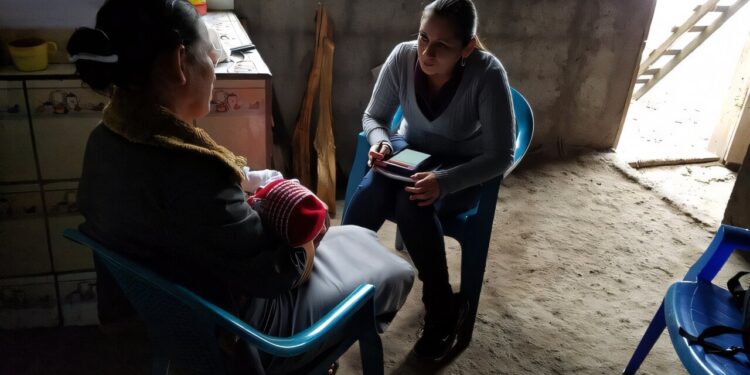Researchers mapped social networks and collected data on the microbiome of residents in 18 isolated villages in Honduras. Credit: Human Nature Lab at Yale
Friends tend to share common interests, tastes, lifestyles and other traits, but a new Yale-led study demonstrates that similarities between friends can also include the makeup of the microbes lining their guts.
The study, published in the journal Natureexamined the relationship between the structure of people’s social networks and the composition of their microbiomes – the bacteria and other microorganisms inhabiting individuals’ gastrointestinal tracts.
For the study, researchers combined comprehensive social network mapping of 1,787 adults living in 18 remote villages in Honduras with detailed data on each participant’s microbiome; the vast database included 2,543 microbial species and 339,137 different strains – closely related genetic variants of the same species that share certain characteristics not found in other members of the species.
They found that people linked through various types of relationships, including nonfamilial and nonfamilial relationships, have similarities in their microbiomes that go beyond what would be expected by chance.
“We found substantial evidence of microbiome sharing between people who are not family members and who do not live together, even after accounting for other factors like diet, water sources and medications,” said co-lead author Francesco Beghini, a postdoctoral associate. at the Human Nature Lab at Yale. “In fact, microbiome sharing was the strongest predictor of social relationships in the villages we studied, beyond characteristics such as wealth, religion or education.”
The greatest amount of microbial sharing occurred between spouses and people living in the same households, but the researchers also observed high rates of sharing among other ties, including friends, or even second-hand social ties. degree (such as friends of friends). Additionally, people located at the center of social networks were more similar to the rest of the villagers than people located at the social periphery, consistent with a social flow of microbes across network ties within villages.
The frequency with which people spend time together, including how often they share meals or how they greet each other, whether with handshakes, hugs or kisses, was also associated with an increase microbial sharing.
At the same time, researchers observed less microbial sharing between people residing in the same village and lacking social relationships with each other. They found even less sharing between individuals living in separate villages.
Two years after initial data collection, researchers remeasured the microbiomes of a subset of 301 participants from four villages. They found that individuals in this subset who were socially connected became more microbially similar than those who were not connected.
The researchers also found that clusters of microbial species and strains occur within groups of people within villages, meaning that social networks provide niches in which individuals develop similar microbiomes.
“Think about how different social niches form in a place like Yale,” said co-lead author Jackson Pullman, a 2023 Yale College graduate and undergraduate research assistant in the Human Nature Lab when the study was launched. been conducted. “You have groups of friends focused on things like theater, teamwork, or physics studies. Our study indicates that the people in these groups can be connected in ways we never imagined before, even through their microbiomes.”
The findings have both negative and positive implications, the researchers said. For example, they suggest that certain diseases or health conditions associated with the microbiome are more transmissible than previously thought. But they also indicate that the benefits associated with a healthy microbiome are transferable through social media.
“The fascinating thing is that we are so interconnected,” said Pullman, who now runs an artificial intelligence startup he founded in the health tech sector. “These connections go beyond the social level to the microbial level.”
The study’s lead author, Nicholas Christakis, Sterling Professor of Social and Natural Sciences in the Yale School of Arts and Sciences, directs the Human Nature Lab, which studies questions at the intersection of the social sciences , biological and computational.
“My lab is very pleased to publish this paper, because it reflects the continuation of an idea we formulated in 2007, namely that phenomena like obesity could spread not only by social contagion, but also by biological contagion , perhaps via the ordinary bacteria that inhabit human guts,” said Christakis, principal investigator of the project.
Additional co-authors are Marcus Alexander and Shivkumar Vishnempet Shridhar, both of the Human Nature Lab; Drew Printer of Johns Hopkins University; Adarsh Singh and Ilana L. Brito of Cornell University; Rigoberto Matute Juárez of Soluciones para Estudios de la Salud in Honduras; and Edoardo M. Airoldi of Temple University.
More information:
Francesco Beghini et al, Sharing of intestinal microbiome strains within social networks of isolated villages, Nature (2024). DOI: 10.1038/s41586-024-08222-1
Provided by Yale University
Quote: Social connections modify our microbiomes, suggests a study of isolated villages (November 20, 2024) retrieved November 20, 2024 from
This document is subject to copyright. Except for fair use for private study or research purposes, no part may be reproduced without written permission. The content is provided for informational purposes only.



